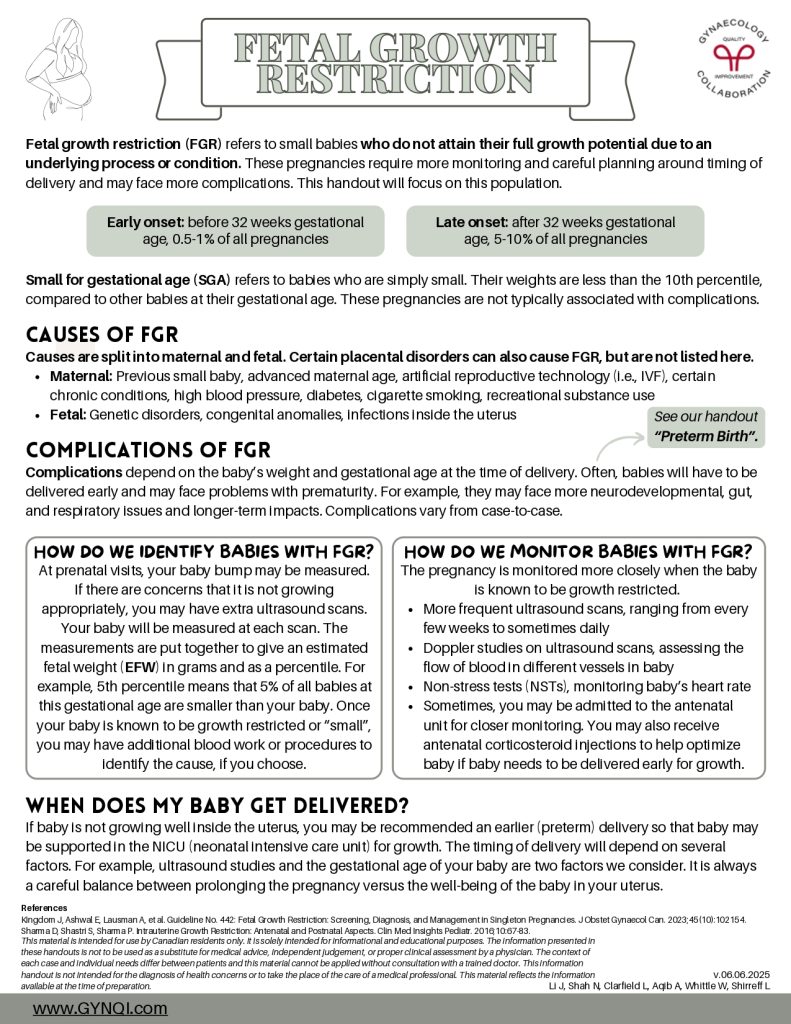
Fetal Growth Restriction
Fetal growth restriction (FGR) refers to small babies who do not attain their full growth potential due to an underlying process or condition. These pregnancies require more monitoring and careful planning around timing of delivery and may face more complications. This handout will focus on this population.
Early onset: before 32 weeks gestational age, 0.5-1% of all pregnancies
Late onset: after 32 weeks gestational age, 5-105% of all pregnancies
Small for gestational age (SGA) refers to babies who are simply small. Their weights are less than the 10th percentile, compared to other babies at their gestational age. These pregnancies are not typically associated with complications.
Causes of FGR
Causes are split into maternal and fetal. Certain placental disorders can also cause FGR, but are not listed here.
- Maternal: Previous small baby, advanced maternal age, artificial reproductive technology (i.e., IVF), certain chronic conditions, high blood pressure, diabetes, cigarette smoking, recreational substance use
- Fetal: Genetic disorders, congenital anomalies, infections inside the uterus
Complications of FGR
Complications depend on the baby’s weight and gestational age at the time of delivery. Often, babies will have to be delivered early and may face problems with prematurity. For example, they may face more neurodevelopmental, gut, and respiratory issues and longer-term impacts. Complications vary from case-to-case.
See our handout “Preterm Birth”.
How Do We Identify Babies With FGR?
At prenatal visits, your baby bump may be measured. If there are concerns that it is not growing appropriately, you may have extra ultrasound scans. Your baby will be measured at each scan. The measurements are put together to give an estimated fetal weight (EFW) in grams and as a percentile. For example, 5th percentile means that 5% of all babies at this gestational age are smaller than your baby. Once your baby is known to be growth restricted or “small”, you may have additional blood work or procedures to identify the cause, if you choose.
How Do We Monitor Babies With FGR?
The pregnancy is monitored more closely when the baby is known to be growth restricted.
- More frequent ultrasound scans, ranging from every few weeks to sometimes daily
- Doppler studies on ultrasound scans, assessing the flow of blood in different vessels in baby
- Non-stress tests (NSTs), monitoring baby’s heart rate
- Sometimes, you may be admitted to the antenatal unit for closer monitoring. You may also receive antenatal corticosteroid injections to help optimize baby if baby needs to be delivered early for growth.
When Does My Baby Get Delivered?
If baby is not growing well inside the uterus, you may be recommended an earlier (preterm) delivery so that baby may be supported in the NICU (neonatal intensive care unit) for growth. The timing of delivery will depend on several factors. For example, ultrasound studies and the gestational age of your baby are two factors we consider. It is always a careful balance between prolonging the pregnancy versus the well-being of the baby in your uterus.



